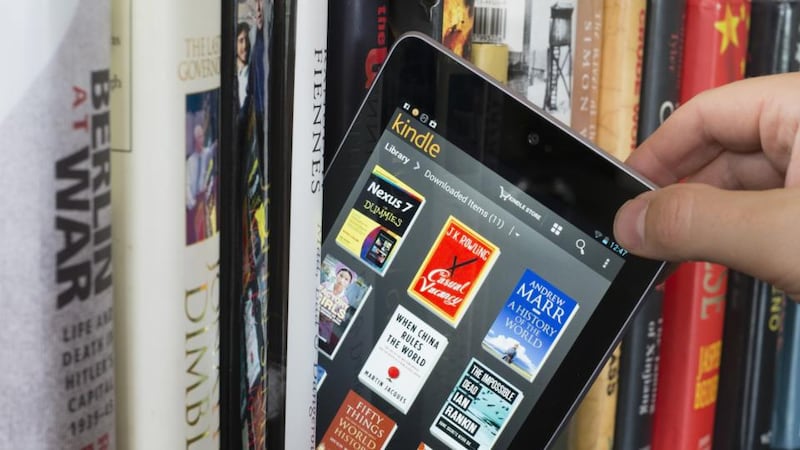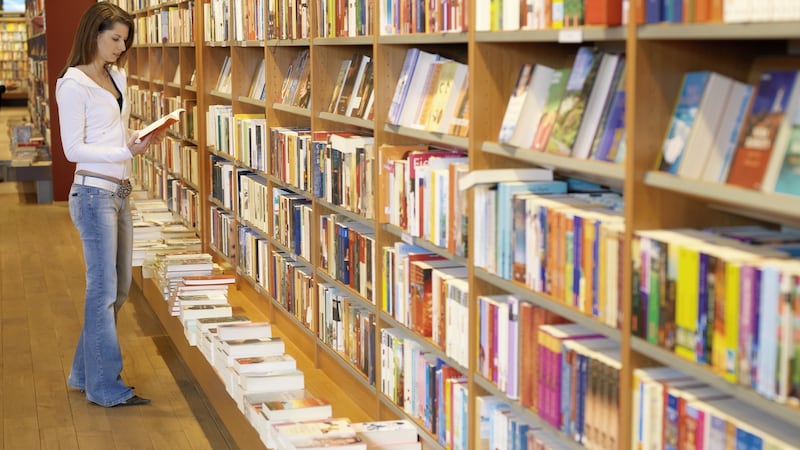Technology rarely takes prisoners and it crushes – virtually – everything in its path. In the past 15 years technology has seen off almost all physical manifestations of music and film, replacing them with downloads and streaming services. Newspapers are endlessly under its cosh as its fake promise of endlessly free content lures people away from newsprint into a digital world of sometimes dubious merit. And it has mortally wounded countless bricks-and-mortar businesses and concepts we used to take for granted.
How many people go into travel agents any more? Does anyone even remember the speaking clock?
But there is one old school technology that is fighting back and, despite a few early setbacks when it seemed to be tilting at windmills, the book seems to be winning the war against the machine.

For hundreds of years books have been remarkably resilient at halting the advances of technology. While music was hopping like a Whirling Dervish from cylinders to vinyl to cassettes, to CDs, to mini-discs to ones and zeros stored on your computer’s hard drive and then on to something even more ephemeral in the form of streamed content, the book has stayed largely the same since Miguel de Cervantes first had a novel notion.
But it faced, perhaps, its greatest threat just over a decade ago when Amazon. com's chief executive, Jeff Bezos, asked a simple question: "Can you improve upon something as highly evolved and well suited to its task as the book? And if so, how?"
Then he answered his own question or at least thought he did. For almost a decade after 2007 his Kindle – and other e-readers – were the shiny new things and many people (including Pricewatch, for the sake of full disclosure) presumed the technological advances heralded the end of the book as we have always known and loved it.
Boom trade
But the tide has turned again. Last year the book trade in Ireland was boomier than an Irish bank at the height of all that madness back in the day. The rise and rise of the printed book here is part of a global phenomenon. According to the most recent figures from Nielsen in the UK, more than 360 million books were sold there last year, 2 per cent higher than in 2015. There was a 4 per cent rise in sales in actual shops while ebook sales fell by 4 per cent, the second year in a row sales declined.
Ebooks now often cost the same or, in some instances, more than physical copies
Nielsen put much of the bounce in print sales down to children’s fiction. Another reason the positions have been reversed is price. Amazon used to charge a lot less for its digital versions than it did for its printed ones but ebook prices have climbed in recent years and now often cost the same and, in some instances, more than physical copies.
US courts are at least partially to blame or thank as a couple of years back they gave publishers – and not Amazon – the right to set prices for ebooks. And publishers set them high.
While climbing prices are rarely good news for consumers, they just might be here. Certainly, the resurgence of the book is good news for everyone, or at least anyone who values the immense and invaluable work authors all over the world put in to their craft, all too often for far too little reward.

New authors
But books are not all about price. “I would like to think the publishers have been very good at seeking out new authors,” says the managing director of Penguin Ireland, Michael McLoughlin, when asked how paper has seen off – at least so far – the challenge of the digital world.
“Authors, publishers and retailers work closely together, and together we have improved the industry,” he says. “Books look better, bookshops are more attractive places and, of course, ultimately it is about finding and supporting authors.”
McLoughlin stresses the importance of the children’s market. “It has been one of the biggest growth areas in recent years. Publishers have worked incredibly hard to make physical books for children look better and that is hugely important because if we can create the reading habit in children, it will stick with them forever.”
What people want sometimes is a little bit of space, a disconnect. The physical book gives them that
It is not just the look and feel of a physical book that matters to children but also the impact it has on their minds, McLoughlin says. “Reading a physical book is a very different experience to reading a digital one and what people want sometimes, particularly young people who are constantly bombarded with information, is a little bit of space, a disconnect. The physical book gives them that.”
Liz Nugent is a writer on a roll right now having written two quite brilliant thrillers – Unravelling Oliver and Lying in Wait – and signed a six-figure deal with US publisher Simon & Schuster which will see both published in the US early next year.
When you buy a book, it's yours forever. And they also make for great insulation
Pricewatch interrupted her as she was putting the finishing touches to her third novel to get her take on the physical book’s resurgence. Having never been in thrall to the electronic options she is pretty pleased. “I only buy physical books, I feel that were I to buy ebooks, I wouldn’t actually own them, I would only be borrowing them and could only have them for as long as the e-reader lasted or as long as the company I bought them off said I could have them. When you buy a book, it’s yours forever. And they also make for great insulation. I have the walls of my house lined with books and I’m convinced that’s why it is so warm.”
Physical benefits
Her list of reasons why she prefers the physical over the virtual book is longer than ownership and insulation. "If I buy a book, I can do whatever I want with it. I can keep it, or loan it to someone or give it away. And I love the Oxfam second- hand bookshop on Parliament Street. You can't donate an ebook. And if you have an ebook of mine, I can't sign it. But one of the best things about being a writer is the egalitarian nature of my world. Anyone can read my books. They don't have to pay for them – they can borrow them off friends or buy them second-hand or get them from a library. I don't really mind how people read, all I want is for them to keep reading. That is what matters most."
People reading certainly matters to Bob Johnston, owner of the Gutter Bookshops in Temple Bar and Dalkey. He has worked as a bookseller for the past 27 years and has seen a lot of trends come and go and sometimes come again.
We like tactile things and things of beauty, and books are getting more beautiful
“My bookshop has been going for eight years now and year on year our sales have gone up and up,” he says. “I think sometimes people feel pushed into acquiring new technologies. But maybe not so much when it comes to books. They do everything that you need them to do. You can carry them around, you can dip in and out whenever you want. They are not dependent on electricity or technology working. We also have a certain relationship with books. We like tactile things and things of beauty, and books are getting more beautiful.”
Books also say things about us, he says. “When I go into someone’s house, the first thing I do is look at their bookshelves. They always tell me something about the person. And bookshops have a lot going for them and serve as refuges, community centres and places where you can just go for a browse. The technology is perfect.”
A librarian’s perspective
Hugh Murphy is a senior librarian at Maynooth University Library and has been steeped in books for almost his entire adult life. He describes the development of the e-book and the pushback by the paper book as “a particularly fascinating area for librarians at the moment”. On that basis we asked if he could write a few words for us. He agreed.
“You could argue that the challenge posed by technology has been overstated as it assumes that the content of the book is all there is. The reality is that a well-crafted physical book is more than just the words inside; it has its own artefactual quality.
As such they more easily associate themselves with moments in your life or as a tactile object they stimulate a more diverse array of feelings than their electronic surrogates. In this sense you can trace a link between the enduring appeal of the printed book and the revival of other analogue media such as vinyl.
Print books also lend themselves to a greater focus - you can truly lose yourself in one, rather than looking at an e-book on your tablet, but being constantly being bombarded by social media updates. That’s not even considering tired eyes and parents worried about too much ‘screen time’.
In terms of the potential of electronic: to date a lot of what we consider ‘e’ have been nothing more than a digital surrogate. In the main this is fine, because a lot of users don’t want to interact any further with the text (how often have you used the ‘highlight’ function on your Kindle for example?) but it suggests that the more transformative possibilities which would be afforded by a truly ‘virtual book’ are either not needed by most readers, or not sufficiently compelling for the publishers and vendors to invest significantly in yet. When those possibilities are harnessed correctly (online comics are a good example) they actually can add value beyond simple access.
In Maynooth University, we hit the ‘tipping point’ (where our electronic collections outnumbered our print), four years ago, but for an academic library, the reality is that a lot of subjects disciplines still operate predominantly in the print medium - especially textbooks, which are a key undergraduate tool. Our lending of print books has remained relatively steady despite the greater numbers of electronic content available.
That said, use of e-books continues to rise and our local research suggests this is due to availability and accessibility but also the reality of what is on the reading list for a student’s course, which is shaped by the academic delivering the course and the scope of what is available.
From a learning perspective, it’s becoming more apparent that reading a print book allows for greater retention, in much the same way that handwriting lecture notes tends to ensure greater absorption of information. So, while the electronic book will always have an advantage if you are trying to find key terms quickly in a very dense text, actual comprehension and retention is not necessarily going to be any better - it may well be worse.
There is no doubt that digital and electronic offer some advantages - for our students, the ability to always access them anywhere is a very compelling benefit. Personally, I don’t think that print will lose its currency anytime soon - I don’t see books existing exclusively as museum pieces, partly because they still proliferate as a medium. It’s more likely that certain types of books will lose more ground - travel guides being a good example. As long as people crave something more than simply ingesting content, they will continue to a critical role. And they look a lot better on a shelf!




















